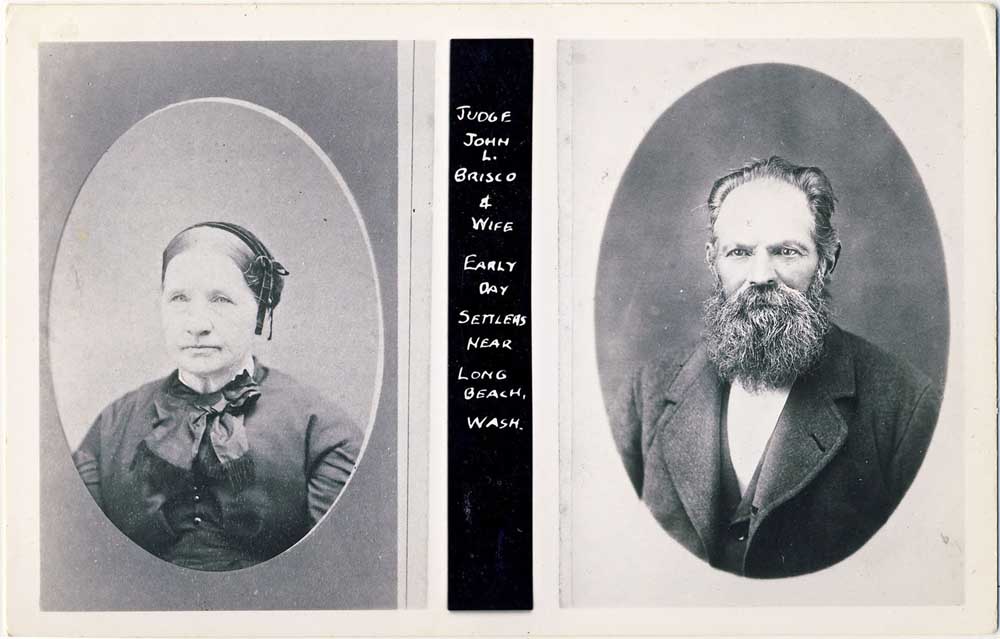Saints or Sinners? Characters of Pacific County: Early judge was a big believer in lawsuits
Published 12:30 pm Saturday, May 4, 2024

- PRIVATE COLLECTIONThe Briscoes were notable early residents of Pacific County, which was Washington Territory’s third county, carved out in 1851.
Judge John Briscoe (1812-1901)
There were a plethora of judges among the pioneers of Pacific County. Perhaps they were all necessary since even a cursory examination of early court records reveals that our forefathers were a litigious lot and seemed to sue each other at the drop of a hat. Or more accurately at the construction of a fence along a property line. Judge John Briscoe, himself, was exemplary in the matter of bringing suit against his neighbors.
Nevertheless, he was appointed and/or elected to many prominent positions beginning soon after his arrival on the Weather Beach in 1853. He was of Quaker parentage, married to Lucy Keeler (with whom he would share 50 years and have eight — possibly 10 — children), had grown up in Newtown, Connecticut, joined the Masonic Order in 1837 and moved to Indiana in 1842. In 1853, he arrived in Pacific County and judged it a fine area for farming.
Briscoe was elected to the Territorial Legislature in the spring of 1854 and attended his first session in December. He was re-elected in 1856, 1858 and 1860. Additionally, he was appointed the first probate judge of Pacific County by Gov. Stevens in December 1854 and was elected an additional three times for a total of 11 years. He also served a brief stint as a deputy sheriff under Sheriff Job Lamley in 1854, enlisted as a private in the Territorial Militia, was appointed postmaster at Oysterville from 1854-1857 and was a trustee on the board of the Methodist Church.
As busy as he must have been with political and community affairs, his farm on his Donation Land Claim on the west side of the Peninsula flourished. By 1860, as his duties at the Pacific County Courthouse increased and with his farm operating smoothly and profitably, Briscoe established a second residence and business center in Oysterville, the county seat.
In all, Brisco purchased more than 25 lots in Oysterville during the years 1860 to 1895. Besides buying the Crellin Store, Brisco purchased two parcels nearby upon which he built a commodious house and, to its east, an additional store which did a brisk business in novelties, furniture, cigars and tobacco. Above the second store was a hall that he ran as an entertainment center. For five years, the U.S. Post Office was also located in one or the other of his stores, Briscoe Sr. serving as postmaster from 1874 to 1877 and his son Burr serving in that capacity for the two following years.
‘Despite all of his public service and his various entrepreneurial enterprises, Briscoe’s disagreements with business associates, neighbors and the general populace escalated as the years went by.’
However, despite all of his public service and his various entrepreneurial enterprises, Briscoe’s disagreements with business associates, neighbors and the general populace escalated as the years went by. It was in defense of principal or “point of law” which would land him in court over and over again. It was obviously worthwhile to him. Perhaps, in his defense, it should be pointed out that many of the movers and shakers of early Pacific County (including my own great-grandfather R.H. Espy) were also in court frequently, most often contesting or defending boundary disputes.
On a lighter note: Whether or not the school children of Oysterville were impressed with Judge John Briscoe’s many credentials and accomplishments, they certainly had a healthy respect for his bull. One of the enduring stories from the early 1900s, told and retold over the years, took place when school was being held at the Methodist Church after the two-story schoolhouse had burned down. Said teacher Alice Holm, many years later:
There was the day, too, when mothers all over the village became aware, just before supper time, that none of their offspring had come home from school. When one of the fathers was sent to investigate the absences, he found the Briscoe bull, a notoriously cantankerous animal, broken loose from pasture, still belligerently pawing the ground at the foot of the church steps where he had kept the frightened teacher and the rest of us prisoner for the last two hours. (This was at Mr. Clark’s Methodist Church of 1872, not to be confused with Mr. Espy’s Baptist Church which stands today).









